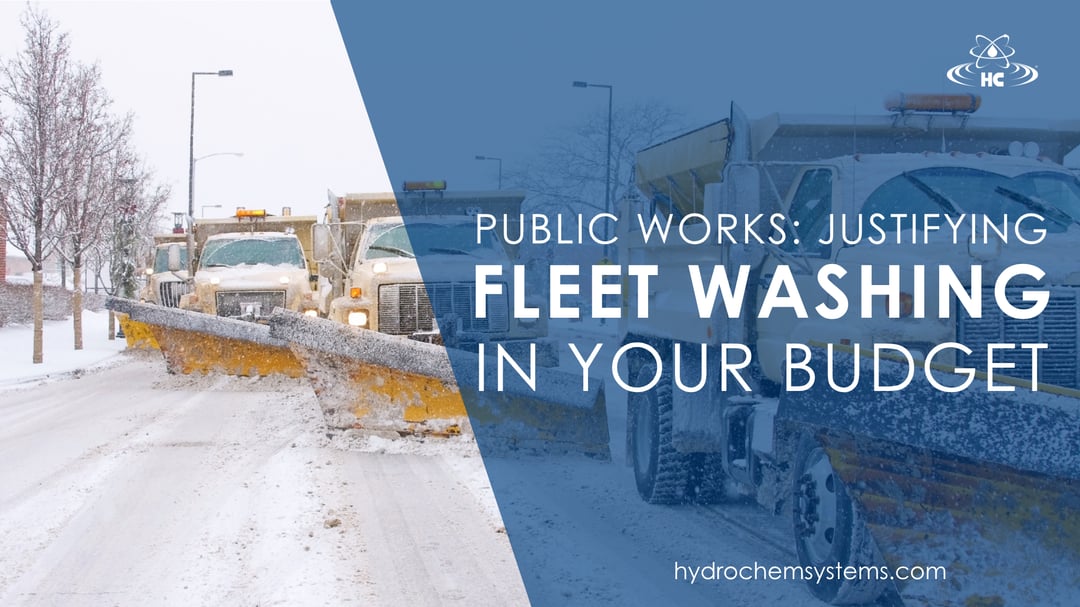Public works fleet managers know that regular washing protects taxpayer-owned vehicles from salt damage and premature failure. The challenge is justifying that investment when councils see it through a taxpayer's eyes.
When someone asks, “Why spend money to make trucks look pretty?” you need the right answer. And it’s not, “The trucks look better when they’re clean.”
Say this instead: “We're protecting our vehicle investment from salt corrosion. The corrosion that costs thousands in premature replacements and rusted out parts.”
Public works departments across 19,000+ North American municipalities are under pressure to do more with less. The fleet managers who keep their programs funded aren't the ones defending appearance. They're the ones showing measurable return on investment (ROI).
Here's how to make that case.
When The Capital Investment Gets Questioned
The challenge: justifying a $150,000+ investment in washing equipment.
You might make this case to your city manager. Or you might answer questions from a commission in a budget hearing. Either way, you need the same strong argument.
You're likely already washing trucks, whether it’s manually with pressure washers with existing staff, or through a contracted outside service. But when decision-makers see “$150,000+ automated wash system” in your capital budget, they start asking questions:
“Why spend that much on washing equipment?”
“Can't we keep doing what we're doing?”
“That's a lot of money for something we're already handling.”
They think the current approach works. Trucks seem to get washed. The cost is spread across operating budgets or service contracts. So a $150,000 line item looks like a discretionary upgrade.
The problem? What you're spending now isn't as visible as that capital number — but it's often much higher over time. And deferred maintenance from inconsistent washing doesn't wait for better budget years.
Reframing Fleet Maintenance as Asset Protection
Nobody skips oil changes to save money. Everyone knows an engine without oil dies fast. Public works fleet maintenance works the same way.
The American Public Works Association defines public works as “sustaining physical assets.” Washing isn't about appearance. It's about protecting the community's investment in equipment that costs, at a minimum, tens of thousands of dollars per vehicle.
In the salt belt regions, salt corrodes brake systems and eats through undercarriages. It greatly accelerates wear on every exposed component. You need to reduce and remove corrosive materials before they cause expensive damage.
When a northern Michigan road commission ran the numbers, they were able to prove they weren't just cleaning trucks. They were protecting assets, and the ROI was measurable.
The ROI That Convinces Decision-Makers
The Road Commission installed an automated drive-through wash system. Here's what happened:
They saved $9,000 to $15,000 per year in brake valve replacements alone. Not total maintenance savings—just brake valves. Full savings include reduced downtime, fewer repairs across systems, and longer component life.
They cut wash time by 90%—from 60 minutes of manual washing to 2.5 minutes automated. Your limited staff spends time on skilled work instead of holding a pressure washer wand for an hour.
Vehicle resale values increased by more than 15%. Clean trucks with documented maintenance histories command premium prices.
They now wash every vehicle multiple times per week. Regular washing prevents salt from sitting long enough to cause corrosion.
Look at the payback. Even what feels like an expensive system, costing between $130,000 to $250,000, will last at least a decade. In most cases, its lifespan is 20+ years. You're saving thousands per vehicle annually in maintenance alone. This is before labor efficiency and resale value are factored in.
Cost per wash: Manual washing generally runs $15 to $30 per vehicle at best. Automated systems often cost $3 to $10 per wash at most, after the capital investment.
The workforce angle matters too. Reducing wash time from 60 minutes to 2.5 minutes means your already stretched staff can focus on work requiring their expertise, instead of washing a dirty vehicle in freezing weather.
Making Your Case During Budget Season
Document what you're spending now. Track labor hours on manual washing, multiply by hourly wages, and add materials. That's your current cost. Try to track how often trucks aren’t washed due to time, energy, or effort.
Photograph the problem. Being able to show corrosion buildup on undercarriages and how fast the very expensive pieces of equipment rust out is important. Visual evidence cuts through budget spreadsheets.
Position this in your Asset Management Plan, not as discretionary spending. This belongs in capital improvement projects alongside other preventative maintenance.
When you present to the budget committee, use language that reframes the conversation:
- "Protecting taxpayer investment in public assets"
- "Preventive maintenance that extends vehicle lifespan"
- "Documented ROI with measurable savings"
You're not asking for pretty vehicles. You're asking for asset protection that saves money over time.
You've Got the Case. Now Make It.
You walked into this knowing that fleet washing protects your assets. Now you've got the numbers that prove it. Along with the language that reframes it, and a real-world example that shows the ROI.
Many public works make the case successfully, including the Michigan road commission. Their numbers are documented. Their results are measurable. You can do the same.
Download our complete PWX presentation from the APWA Snow Conference and more in our Public Works resources. You’ll find comparisons of washing methods and cost analysis. It’s good inspiration for how to present the investment to decision-makers.
At Hydro-Chem Systems, we've helped fleets find a better way to wash for more than 50 years. We can help public works departments justify these investments. Contact us if you want to walk through the numbers for your specific fleet size and washing needs.
Your fleet is a public asset. You know how to protect it.


